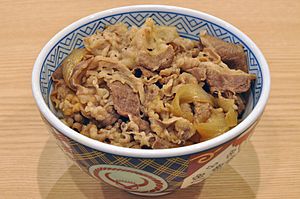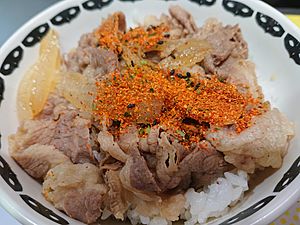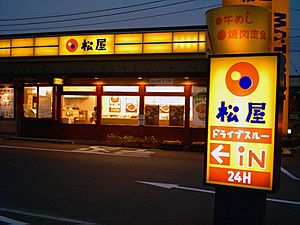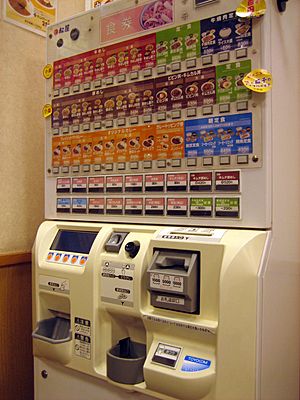Gyūdon facts for kids

Gyūdon from a Yoshinoya restaurant
|
|
| Alternative names | gyūmeshi ('beef [and] rice'), beef bowl |
|---|---|
| Place of origin | Japan |
| Main ingredients | rice, beef and onion |
Gyūdon (牛丼, "beef bowl"), also known as gyūmeshi (牛飯 or 牛めし, "beef [and] rice"), is a popular Japanese dish. It's a tasty bowl of rice topped with thin slices of beef and onion.
The beef and onions are cooked in a mildly sweet sauce. This sauce gets its flavor from dashi (a broth made from fish and seaweed), soy sauce, and mirin (a sweet rice wine). Sometimes, people add extra toppings. These can include a raw or soft-cooked egg, Welsh onions, grated cheese, or even kimchi. In Japan, Gyūdon is often eaten with beni shōga (pickled ginger), shichimi (ground chili pepper), and a side of miso soup.
Contents
History of Gyūdon

For a long time, eating meat was not common in Japan. After Buddhism arrived in Japan in the 6th century, many people avoided eating meat, especially from animals like cows or pigs. This was often for religious reasons.
However, things changed after 1868. This was during a time called the Meiji Restoration. Japan started to adopt some Western customs, and eating meat became more popular.
Gyūdon is thought to have come from a dish called gyūnabe (say "gyoo-nah-beh"). This was a beef hot pot dish from eastern Japan. Originally, gyūnabe had beef cooked with Welsh onions and miso. Later, a different version appeared. It used a special sauce called warishita (a mix of sweetener and soy sauce). This version also added ingredients like shirataki (noodle-like strips made from konjac) and tofu.
This newer gyūnabe eventually became known as sukiyaki. People started serving this sukiyaki with rice in a deep bowl called a donburi. This is how gyūmeshi or gyūdon was born!
By the 1890s, gyūmeshi was very popular in Tokyo. In 1899, Eikichi Matsuda opened the first Yoshinoya restaurant in Tokyo. Gyūdon was also sold from food stands called yatai in the streets.
At first, gyūdon was seen as a simple meal for working-class people. But its popularity grew a lot after the Great Kantō Earthquake in 1923. After the earthquake, Tokyo was devastated, and gyūdon was one of the few foods easily available. Around this time, gyūdon became what it is today: a bowl of rice topped with thin slices of beef and onions.
Today, most gyūdon restaurants serve it simply with rice, beef, and onions. Some places still offer it with sukiyaki-like toppings, but that's less common.
Gyūdon as Fast Food
You can find gyūdon in many restaurants across Japan. Some fast food chains focus only on this dish. Many of these chains are open all day and night. The three biggest gyūdon chains in Japan are Sukiya, Yoshinoya, and Matsuya.
- Sukiya started in Yokohama in 1981 and is currently the largest gyūdon chain.
- Yoshinoya is the oldest, opening in Tokyo in 1899, and is the second largest.
- Matsuya started in Tokyo in 1968.
Sometimes, these restaurants use different names for gyūdon. For example, Matsuya calls its gyūdon gyūmeshi. Another chain, Hanamaru Udon, which mainly sells Sanuki udon noodles, has a dish called gyūniku gohan (which means "beef rice").
Matsuya is known for giving free miso soup to customers who eat in, while other places might charge for it.
How to Order Your Gyūdon
Some gyūdon chains let customers order their dish in a special way. They use code words! For example, tsuyudaku (say "tsoo-yoo-dah-koo") means you want extra broth (called tsuyu) on your gyūdon. You don't have to pay extra for this.
Tsuyudaku means a lot of the juice and broth mixture. If you want less broth, you can say tsuyunuki. And if you want even more broth than tsuyudaku, you can ask for tsuyudakudaku! Sometimes, people even ask for tsuyudakudakudaku for a super soupy bowl.
One idea about where daku comes from is the word takusan, which means "many" or "a lot." When daku is repeated, like daku-daku, it sounds like dripping.
The idea of tsuyudaku started with Japanese business people. They were often in a hurry on their way to work. They would ask for extra soupy gyūdon so they could eat it very quickly. This became so common that the term tsuyudaku spread quickly among gyūdon restaurants.
Beef Ban in Japan
In 2004, there was a concern about a disease called "mad cow disease" (Bovine spongiform encephalopathy). Because of this, Japan stopped importing beef from the United States. This meant that many gyūdon restaurants, like Yoshinoya, had to stop selling gyūdon in Japan on February 11, 2004.
Instead, Yoshinoya started selling a similar dish made with pork. They called it butadon (豚丼). Sukiya, another chain, continued to sell gyūdon by using beef from Australia. They also added a pork dish called tondon to their menu. (Both buta and ton are Japanese words for "pig" or "pork.")
The Japanese government voted to allow beef imports from the United States again in May 2005. However, the ban was put back in place in January 2006. This happened because some banned parts of the cow were found in the first shipments of beef. People who loved gyūdon and the restaurants waited for the issue to be fixed. The ban was finally lifted in September 2006.
Images for kids
See also
 In Spanish: Gyūdon para niños
In Spanish: Gyūdon para niños









